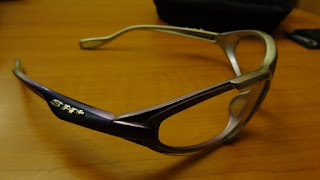Have you ever went outside and felt like the sunlight is too bright for you?
Sometimes this happens even if the sky is cloudy. This is either because your are naturally more sensitive to sunlight (green and blue eyed people are prone to photophobia) or you stayed in low light (indoors) for a prolonged time and your eyes can't adjust to the new brighter daylight.
In any case, having a pair of sunglasses is always helpful.
So here are some short notes about what you may wanna consider when choosing your sports and mountaineering sunglasses:
Interchangeable lenses and UV protection
If you enjoy outdoor activities, a pair of sunglasses with interchangeable lenses is a must. Basically, you get 3 pairs of lenses, each for a different lighting situation.
The most common combination consists of dark, orange and clear lenses.
I personally use the orange lenses for foggy weather, while riding my mountain hike in the forest or while cycling in the city in cloudy weather. You should use your sunglasses as dust protection as well - especially when cycling or when it's windy. (Have you ever bumped your eye into flying bugs while speeding on your bike?)
Clear lenses are perfect for night activities where you need wind protection and clear vision: cycling, roller & skating (no cars on the streets late at night), night skiing, mountaineering.
You can also use your glasses as goggles with the clear lenses. When I drill metal for my DIY widgets, that's what I'm wearing.
The dark lenses are for bright light - not very hard to figure it out, right? -. High altitude mountaineering, sunny summer days trekking, on the beach, on a boat, or in any other situation where the snow or water reflects the sunlight back requires UV 400 lenses.
You want to block as much of the UV rays as possible, especially on the mountains where the sun beams are less filtered since the above atmosphere is thinner.
Also when working extensively outdoors with specific materials that have glare (aluminum sheets, solar panels, etc.) a dark lens is advisable.
Another thing you may want in your sunglasses is the possibility to add prescription eye sight lenses. These glasses have an extra set of frames behind the main outer frames or they have optic lenses that automatically darken when the light is brighter (heliomatic).
A smart padded case so you won't break your glasses or lenses
I broke three pairs of sunglasses just coz I didn't have a proper case.
Now, most decently good brands come with a smart case so you can safely keep your lenses and glasses. This is helpful as you may forget you have them in your pack; then you throw your backpack down on the ground and sit on it. That's how I broke mine. :-)
Mine are made by SH+ and I'm very happy with everything: case, design, lenses and fit.
However, the large sport store chains have their own trademark of sport sunglasses and the quality is similar with any other known brands. They come with nice cases as well and are usually more affordable.
Fit and comfort
This is the part where you have to try on various styles and brands. Each have their own geometry and each of us have a different profile.
Once you find the perfect fit - I prefer a close and tight fit as it provides the best anti-wind protection - you have to make sure you have comfort. By this I mean not experiencing pain or rashes on your nose after long hours of wearing the sunglasses.
So look for glasses with silicone/rubber nose pads and comfortable ear pieces. These grant comfort and a firm hold.
Conclusion
No matter what sports you do, a good pair of sunglasses is an important piece of gear for your overall comfort and good disposition.
Try on different brands and styles and choose one that fits you in every detail.
Be cool, wear your sunglasses and also apply sunscreen if you don't wanna get windburn!
Thanks for stopping by! Share this article with your friends.


















Good call with the interchangeable lens.
ReplyDeleteI noticed blue lenses are too dark for me. My eyes do best with rose colored or light brown lenses.